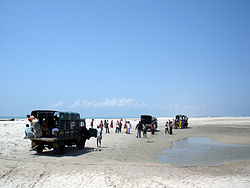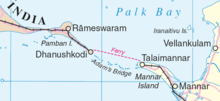- Dhanushkodi
-
Dhanushkodi — town — Coordinates 9°09′07″N 79°26′45″E / 9.152011°N 79.445851°ECoordinates: 9°09′07″N 79°26′45″E / 9.152011°N 79.445851°E Country India State Tamil Nadu District(s) Ramanathapuram Time zone IST (UTC+05:30) Area
• 0 metres (0 ft)
Codes-
• Telephone • +04567
Dhanushkodi or Danushkodi (Tamil : தனுஷ்கோடி) is a town/village at the southern tip of the Rameswaram island, at the eastern coast of the Tamil Nadu state of India.
Dhanushkodi is situated in the South-East of Pamban. Danushkodi is about 18 miles (29 km) West of Talaimannar in Sri Lanka. The Dhanushkodi railway line running from Pamban Station was destroyed in the 1964 cyclone and a passenger train with over 100 passengers drowned in the sea.
Contents
Hinduism
Hindu scriptures says that at the request of Vibeeshana, brother of Ravana and ally of Rama, Rama broke the Sethu with one end of his bow and hence the name Dhanushkodi, Dhanush meaning Bow and Kodi meaning end. It is also said that Rama marked this spot for Setu with one end of his famous bow. Bath in holy Sethu at the junction of the two seas normally precedes the pilgrimage to Rameswaram. A series of rocks and islets found in a line are shown as remnants of the ancient Setu also called as Rama's Bridge.
It is said that Pilgrimage to Kashi will be completed only after the worship at Rameswaram besides a holy bath in Dhanushkodi at the Confluence of Mahodadhi (Bay of Bengal) and Ratnakara (Indian Ocean). Setu is Sanskrit word to denote bridge or causeway. It has now acquired a special significance to mean the bridge across the ocean constructed by Rama to reach Lanka.
1964 Storm
Dhanushkodi has the only land border between India and Sri Lanka which is one of the smallest in the world-just 50 yards in length on a shoal in Palk Strait. Before the 1964 cyclone, Dhanushkodi was a flourishing tourist and pilgrimage town. Since Ceylon (now Sri Lanka) is just 19 miles (31 km) away, there were many ferry services between Dhanushkodi and Talaimannar of Ceylon, transporting travellers and goods across the sea. There were hotels, textile shops and dharmashalas catering to these pilgrims and travellers. The Railway line to Dhanushkodi–which did not touch Rameshwaram then and destroyed in the 1964 cyclone-went directly from Mandapam to Dhanushkodi. Dhanushkodi in those days had a railway station, a small railway hospital, a higher secondary school, a post office, customs and port offices etc. It was here in this island in January 1897, Swami Vivekananda after his triumphant visit to the west to attend parliament of religions held in USA in September 1893, set his foot on Indian soil from Columbo.
The area around Rameshwaram has been frequently ravaged by several high-intensity cyclones and storms in the past. A scientific study conducted by the Geological Survey of India[1] indicated that the southern part of erstwhile Dhanushkodi Township facing Gulf of Mannar sank by almost by 5 meters during 1948-49 AD due to vertical tectonic movement of land parallel to the coastline. As a result of this, a patch of land of about half a km in width stretching 7 km along North-South direction submerged in sea along with many places of worship, residential areas, roads etc. Incidentally, Tanjavur (Tanjore) Raja’s choultry, a known dharmasala for pilgrims in those days, located in this area, also submerged.
Before the 1964 storm, there was a train service up to Dhanushkodi called Boat Mail from Madras Egmore (Now Chennai Egmore) and the train linked to a steamer for ferrying travellers to Ceylon.
The storm was unique in many ways. It all started with a formation of a depression with its centre at 5N 93E in South Andaman Sea on 17 December 1964. On 19 December it intensified into a cyclonic storm. The formation of depression at such low latitudes as 5N is rare in Indian seas though such cases of typhoon development within 5 degrees of Equator has been reported in North Western Pacific. The Rameshwaram storm was not only formed at such low latitude but also intensified into a severe cyclonic storm at about the same latitude is indeed a rare occurrence. After 21 December 1964, its movement was westwards, almost in a straight line, at the rate of 250 miles (400 km) to 350 miles (560 km) per day. On 22 December it crossed Vavunia of Ceylon ( now called Sri Lanka) with a wind velocity of 150 knots (280 km/h), moved into Palk Strait in the night and crashed into Dhanushkodi of Rameshwaram island on the night of 22–23 December 1964. It was estimated that tidal waves were 8 yards high when it crossed Rameshwaram. A scientific study of the storm by Shashi M Kulshreshta and Madan G Gupta is given at this link [1]
On that night (December 22) at 23.55 hours while entering Dhanushkodi railway station, the train No.653, Pamban-Dhanushkodi Passenger, a daily regular service which left Pamban with 110 passengers and 5 railway staff, was only few yards before Dhanushkodi Railway station when it was hit by a massive tidal wave. The whole train was washed away killing all 115 on board. All together over 1800 people died in the cyclonic storm. All dwelling houses and other structures in Dhanushkodi were marooned in the storm . The high tidal waves moved almost 10 kilometres onto this island and ruined the entire town. Pamban bridge was also washed away by the high tidal waves in this disaster. Eyewitness accounts recollected of how the surging waters stopped just short of the main temple at Rameshwaram where hundreds of people had taken refuge from the fury of the storm. Following this disaster, the Government of Madras declared the town as Ghost town and unfit for living after the storm.Only few fisherfolks now live there.
Memorial for Dhanushkodi Victims
A memorial erected near the Dhanushkodi bus stand reads as follows:
"A cyclone storm with high velocity winds and high tidal waves hit Dhanushkodi town from 22 December 1964 midnight to 25 December 1964 evening causing heavy damages and destroying the entire town of Dhanushkodi"
In July 2010, senior leader of the Bharatiya Janata Party L.K Advani visited Mukundarayar Chaththiram near Dhanushkodi in Rameswaram Island and paid homage at the memorial pillar erected for the victims of 1964 cyclone [2]
Travel
Even though there was a railway line between Pamban and Dhanushkodi and a passenger train used to ply regularly, after the storm the tracks were damaged and in course of time, were covered by sand dunes and hence had to be abandoned. One has to reach Dhanushkodi either on foot along sea shore on the sand dunes or in jeeps and in tempos of fishermen.
There are several temples associated with Lord Rama here. It is advisable to visit the village in groups during the day and return to Rameshwaram before sunset as the entire 15 km stretch is very lonely and scary but mystical.[citation needed] Tourism is budding in this area and a significant police presence to protect the visitors is there. Indian Navy has also set up a forward observation post to guard the sea. At Dhanushkodi one can see the deep and rough waters of Indian Ocean meeting the shallow and calm waters of Bay of Bengal. Since the sea is shallow here, one can walk into Bay of Bengal and witness the colourful corals, fishes, seaweeds, star fishes and sea cucumber etc.
At present, on an average, about 500 pilgrims visit Dhanushkodi daily and the number goes up by thousands during festival days, such as new and full moon days. Regular bus facility is available only up to a certain distance from Rameshwaram via Kodhanda Ram Kovil (Temple) and many pilgrims who wish to perform religious rites at Dhanushkodi have to depend on private vans who charge anything between Rs50 and 100 per passenger depending upon the number of passengers. Following the public demand of pilgrims who visit Rameshwaram from all over the country, in 2003, Southern Railway sent a project report to Ministry of Railways for re-laying a 16 km new railway line to Dhanushkodi from Rameshwaram, the fate of which is unknown.
Solar eclipse:
Annular Solar Eclipse of 15th January 2010 took place at this place.
Gallery
References
- ^ G. G. Vaz, M. Hariprasad, B. R. Rao and V. Subba Rao. Subsidence of southern part of erstwhile Dhanushkodi township, Tamil Nadu. CURRENT SCIENCE, VOL. 92, NO. 5, 10 MARCH 2007.Pg 671-672
External links
Categories:- Gulf of Mannar
- Beaches of Tamil Nadu
- India–Sri Lanka border crossings
-
Wikimedia Foundation. 2010.














